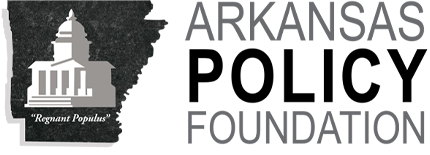“CPI-Expenditures Link. A short-term budgetary link should be established between the Consumer Price Index (CPI) and total operational expenditures by agencies.” Arkansas Policy Foundation, Efficiency Project report (October 2016)
Summary: Policymakers have advanced two ideas that would restrict state spending to growth in personal income or the Consumer Price Index (CPI).
(February 2021) What is the proper growth rate for state spending? For more than a decade this idea has been debated. One idea advanced by U.S. Rep. Bruce Westerman while in the state legislature would limit spending toArkansas personal income growth. More recently, spending at some agencies has increased less than CPI during the administration of Gov. Asa Hutchinson.
CPI Explained
CPI is “a measure of the average change over time in the prices paid by urban consumers for a market basket of consumer goods and services,” according to the U.S. Bureau of Labor Statistics (BLS).(1) “Indexes are available for the U.S. and various geographic areas.” The metric used to measure inflation. The Policy Foundation has relied on CPI in its analyses of state fiscal proposals.
- A 2008 Foundation research memo noted then-Gov. Mike Beebe’s “budget proposal calls for a 3 percentincrease in state spending, a level lower than federal CPI reports or estimates.”(2) A 2012 memo noted, “Long-term Arkansas Medicaid spending exceeded the U.S. average and the Consumer Price Index (CPI).”(3)
Personal Income Explained
Sources include wages and salaries, Social Security and other government benefits, dividends and interest, businessownership, and other income,” explains the U.S. Bureau of Economic Analysis (BEA), which compiles the data.(4)These “offer clues to Americans’ financial health and future consumer spending.”
The Policy Foundation has also relied on personal income as a metric.
- A 2006 memo noted growth in spending for a Medicaid program “exceeded growth in Arkansas per capita personal income in the same period. Per capita personal income in the state grew only 15.7 percent,” while spending on the program was 69 percent in a five-year period.(5)
The issue begs the question: Is it just for government spending to increase at a percentage rate greater than personal income growth?
Westerman Proposal
Before his 2014 election to Congress, U.S. Rep. Bruce Westerman of Hot Springs served in the state House of Representatives (2011-2014). Westerman served as House Majority Leader in his second term. In 2013, he introduced a measure (HB1041) “to impose a cap of general revenue expenditures for each fiscal year; to limit the increase in general revenue expenditures from year to year; (and) to create a nexus between the amount of general revenue expenditures and the growth of the state disposable personal income …” (emphasis added).(6) Rep. Westerman’s bill fell two votes short in the House.(7)
Arkansas general revenue increased at a higher percentage rate (30%) than disposable personal income (26%) through FY2019.(8) But actual expenditures by state agencies increased less (9%) than personal income.(9)
Category FY2015 FY2019
| Personal Income | $106,262,000,000 | $121,680,100,000 | +15% |
| General Revenues | $4,244,241,678 | $5,535,569,333 | +30% |
| Actual Expenditures | $15,506,270,630 | $16,962,239,005 | +9% |
CPI Under Gov. Hutchinson
Gov. Hutchinson’s efforts to streamline state government started when he took office in 2015. The Efficiency Project examined 21 state agencies but not the state Department of Human Services, a major spending source. Five agencies reported lower operational expenditures (FY2015-to-FY2019):(10)
Emergency Management Health
Insurance
Labor
Workforce Services
Another seven spent less than CPI (8.7%)(11) in the period:(12) Career Education (5.5%)
Military (4.7%)
Agriculture (4.3%)
Correction (4.2%)
Education (2.2%)
Finance and Administration (2.1%) Assessment Coordination (1.5%)
The practical effect of the Efficiency Project’s proposed CPI spending limit is that it can incentivize officials to search for efficiencies in a low-inflation environment.
The goal is not unrealistic. The Efficiency Project submitted findings to the Hutchinson administration in 2016. Usingthat year as the baseline, five agencies reported lower operational expenditures (FY2016-to-FY2020):(13) Two others–Agriculture (6.3%) and Education (2.8%)(14)–spent less than CPI (7.0%)(15)
Federal Revenues Drive Spending Above CPI
Federal revenues drove spending above CPI at some agencies. A different picture emerges when federal revenues are subtracted from actual expenditures.
Alternative: Actual Expenditures Less Federal Revenues (FY 2016-2020)
| Agencies | ||
| Aeronautics | ||
| Agriculture | ||
| Bank | ||
| Community Correction | ||
| Correction | ||
| Economic Development | ||
| Education/Career/Higher/MLK | ||
| Emergency Management Environmental Quality | ||
| Health | ||
| Insurance Labor | ||
| Military | ||
| Veterans Affairs | ||
| Workforce Services | ||
| Spending at CPI (7%) | $4,271,469,526 | |
| Total Actual Expenditures | $3,992,027,594 | $4,135,431,874 |
| Difference | $136,037,652 | |
The Department of Human Services is a major source of spending. Actual expenditures were $8,609,138,600 in FY2020. Seventy-four (74%) percent of that amount is from federal revenues, which totaled $6,394,042,863 at the agency in FY 2020.(16) This is an increase of nearly $1 billion in four years. Federal revenues at Human Services were $5,523,364,392 in FY2016.(17)
Conclusion
In the last decade, Arkansas policymakers have advanced two ideas that would restrict state spending to growth indisposable personal income and CPI. The first idea was associated with Congressman Bruce Westerman when heserved in the state House. General revenue grew at a higher rate (30%) than disposable personal income (26%) but less than actual expenditures (9%).
Under Gov. Asa Hutchinson, operational expenditures declined at five agencies. Seven others spent less than CPI.
Federal revenues drove spending above CPI at some agencies. The state Department of Human Services is a major source of growth in spending.
–Greg Kaza
Endnotes
- CPI Home : S. Bureau of Labor Statistics (bls.gov)
- Policy Foundation, November 2008
- Policy Foundation, September 2012
- Personal Income | S. Bureau of Economic Analysis (BEA)
- Policy Foundation, November 2006
- A Westerman amendment relied on the BEA for disposable income
- Westerman’s bill was considered March 5, 2013 and received 49 Yea’s and 47 No’s, with three House members not voting and anotherrecorded as Present. The measure required 51 votes to pass the state House.
- The effective date of Westerman’s proposal was July 1, 2014; fy2015ActualExpenditures.pdf (arkansas.gov);fy2019ActualExpenditures.pdf (arkansas.gov); https://apps.bea.gov/iTable/index_regional.cfm
- DFA reports actual expenditures increased from $13,947,188,743 (FY2013) to $16,962,239,005 (FY2019).
- DFA, Agency Actual Expenditures (arkansas.gov) Emergency Management (FY2015) $39,812,016 (FY2019) $26,583,911; Health;$370,387,770, $284,657,883; Insurance $57,736,238, $57,176,314; Labor
$6,486,450, $6,109,793; and Workforce Services$460,258,462, $182,755,369
- Consumer Price Index, 1913- | Federal Reserve Bank of Minneapolis (minneapolisfed.org)
- DFA, Agency Actual Career Education (FY2015) $136,641,334 (FY2019) $144,216,735; Military $60,832,606,$63,682,811; Agriculture $44,167,159, $46,049,519; Correction $375,658,284,
$391,575,571; Education $3,457,588,679, $3,534,829,391; DFA $985,935,822, $1,006,680,838; and
Assessment Coordination $17,430,818, $17,700,936
- DFA, Actual Expenditures (arkansas.gov). Aeronautics (FY2016) $15,606,288 (FY2020) $8,173,087; Health $341,615,904,$297,729,135; Insurance $57,494,971, $57,449,176; Labor $6,283,336, $6,184,814;
Military$60,832,606, $59,945,045
- DFA, Actual Agriculture $44,167,159, $46,940,370; Education $3,609,293,236,
$3,711,926,292. Under the state government reorganization enacted in 2019, Education includes K-12, Career, Higher, and the Martin Luther King, Jr., Commission.
- Arkansas’ fiscal year begins July 1. CPI-U, June 2015-June 2020, U.S. Bureau of Labor Statistics Consumer Price Index (CPI) Databases: U.S. Bureau of Labor Statistics (bls.gov), “All items in U.S. city “
- pdf (arkansas.gov)
- pdf (arkansas.gov)









